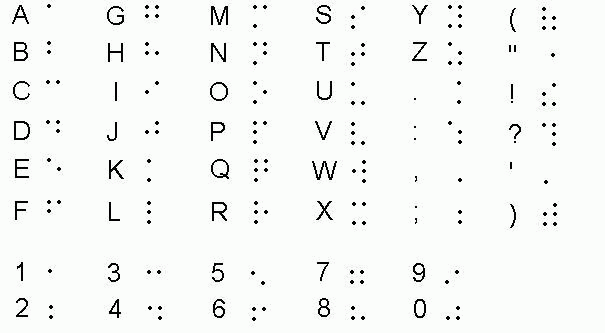
|

|
|
- BRAILLE ALPHABET/NUMBERS - HISTORY - LINKS - |

|
Matt Murdock uses braille quite often in the Daredevil comic, and not just
when he's "pretending" to be blind. Feeling the letters on a document by
the impression the ink leaves requires a LOT of concentration. For every
day reading, braille is much easier for him. I've posted the major
portion of the Braille alphabet above, and an excerpt from the American Council for the Blind web page below.
Their site has a lot of interesting information and links to many other
worthwhile sites. You might also be interested to know that computers are rapidly becoming part of the repertoire of overcoming the difficulties of being blind. Many blind people are starting to take advantage of OCR (optical character recognition) and voice synthesis technology to make their lives easier. A person can scan a page into their computer and then have the computer "read" it to them. Originally, optical character software was very touchy: it could only recognize certain fonts and certain sizes, etc., but this is rapidly improving each year. Also, voice synthesizers which used to sound like sad robots from 1950 sci-fi movies stuck in the bottom of a metal barrel are also improving very rapidly. A number of voice synthesis programs are even beginning to be able to convey emotion and emphasis fairly well. |
|
Braille is a system of touch reading and writing in which raised dots
represent the letters of the alphabet. Braille also contains equivalents
for punctuation marks and provides symbols to show letter groupings.
Braille is read by moving the hand or hands from left to right along each
line. Both hands are usually involved in the reading process, and reading
is generally done with the index fingers. The average reading speed is
about 125 words per minute, but greater speeds of up to 200 words per
minute are possible. By using braille, blind people can review and study the written word. They can become aware of different written conventions such as spelling, punctuation, paragraphing and footnotes. Most of all, blind individuals can have access to a wide range of reading materials including educational and recreational reading and practical manuals. Equally important are the contracts, regulations, insurance policies, directories, appliance instructions and cookbooks that are part of daily adult life. Also, through braille, blind people can pursue hobbies and cultural enrichment with such materials as music scores, hymnals, playing cards, Scrabble boards and other games. Various other methods had been attempted over the years to enable blind people to read, many of them raised versions of print letters. It is generally accepted that the braille system has succeeded because it is based on a rational sequence of signs devised for the fingertips, rather than imitating signs devised for the eyes. In addition, braille can be written by blind people and can be used for any notation that follows an accepted sequence, such as numerals, musical notes or chemical tables. A blind eleven-year-old boy took a secret code devised for the military and saw in it the basis for written communication for blind individuals. Louis Braille, newly enrolled at the National Institute of the Blind in Paris, spent nine years developing and refining the system of raised dots that has come to be known by his name. The original military code was called night writing and was used by soldiers to communicate after dark. It was based on a twelve-dot cell, two dots wide by six dots high. Each dot or combination of dots within the cell stood for a letter or a phonetic sound. The problem with the military code was that the human fingertip could not feel all the dots with one touch. Louis Braille created a reading method based on a cell of six dots. This crucial improvement meant that a fingertip could encompass the entire cell unit with one impression and move rapidly from one cell to the next. The system of embossed writing invented by Louis Braille gradually came to be accepted throughout the would as the fundamental form of written communication for blind individuals, and it remains basically as he invented it. Over time, there has been some modification of the braille system, particularly the addition of contractions representing groups of letters or whole words that appear frequently in a language. The use of contractions permits faster braille reading and helps reduce the size of braille books, making them less cumbersome. Several groups have been established over the last century to modify and standardize the braille code. A major goal is to develop easily understood contractions without making the code too complex.
|
|
www.acbradio.org - American Council for the Blind web radio |
Daredevil TM & ©2004 is the property of Marvel Characters, Inc. - all rights reserved.